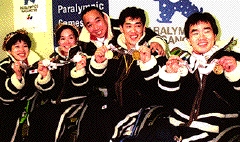|
Science & Technology || Search || Back Numbers
ATHLETES WITH DISABILITIES: Nagano Hosts Biggest-Ever Winter Paralympic Games April 5, 1998  Some of Japan's Paralympic athletes show off their medals. (Photo: Kyodo) The Paralympic Games are the ultimate athletic competition for people with disabilities; the Nagano Winter Paralympic Games, held in March 1998, were attended by 587 participants from 32 countries. This attendance made the Nagano Games the biggest Paralympics ever, surpassing the previous Winter Paralympic Games in Lillehammer in 1994. Japan won 41 medals, including 12 golds, placing behind only Germany in the number of medals won. The high level of competition attracted attention around the world and provided an opportunity to boost public recognition of sports for people with disabilities. Many volunteers turned out to help run the Games, and shopping districts located around each venue took steps to accommodate people on wheelchairs, such as building ramps. It was an event in which people with disabilities joined hands with others to make the Games a big success. Impressive Technique and Strength The 1998 Winter Paralympic Games were the first Paralympic competition held in Japan since 1964, when the Tokyo Paralympics took place in the same year as the Tokyo Olympic Games. The Games have grown considerably in scale, as could be seen at Nagano: Athletes with mental impairments participated for the first time, and six countries--including Iran, South Africa, and Ukraine--were first-time participants. Although Nagano was Japan's first athletic competition for people with disabilities where admission fees were charged, all 91,150 tickets were sold out before the start of the Games. The competition took place in five sports: Alpine skiing, Nordic skiing, biathlon, ice-sledge speed racing, and ice-sledge hockey. In each sport, athletes were grouped according to the type and extent of their disability. Competitors in the skiing and biathlon events used special equipment, such as ski poles with outriggers and ski-chairs. Sledge competitors used seats mounted on two skate blades. Japanese athletes turned in a world-leading performance as they reaped the rewards of their hard training. Spectators found first-class competition in every
event--from Alpine skiers who achieved speeds over 90
kilometers per hour on the steep downhills, to ice-sledge
hockey players who fiercely defended their goals by ramming
their sledge-fitted chairs into attackers. The action
captivated audiences all over the world, who were moved both
by the athletes' diligently honed strength and by the strong
spirit behind their hard training. A large number of Nagano citizens went out of their way to make things easier for these people; for example, merchants added wheelchair ramps at stairs and other drop-offs, and placed stickers at shop entrances to indicate wheelchair accessibility. From mid-January, the producer of the closing ceremony
made announcements in newspapers and over the Internet
calling for people to make and donate origami cranes with
which to decorate the venue. The total number of cranes
easily surpassed the initial goal of a million set by the
organizers: By closing day, they had amassed 7.5 million
cranes from 350,000 groups and individuals. The folded paper
cranes, believed to ensure the realization of one's prayers,
created a splash of color above the athletes' heads as the
stadium was filled with cheers for the highly successful
Games. The Winter Paralympic Games in Nagano were lavishly
praised for bringing people of differing abilities together
and for the heartwarming display of cooperation among all
participants. Sports geared toward people with disabilities face many obstacles, however. For example, ice-sledge racing damages rinks because the players propel themselves forward by jabbing sharp-ended sticks into the ice. It is therefore difficult for racers to secure practice space. Although the Japanese team did well in ice-sledge racing, there are grave doubts as to whether this sport can survive. Paralympic sports also face financial problems. The Japanese government budgeted 144 million yen (1.1 million U.S. dollars at 135 yen to the dollar) for the three years starting in FY 1995 to boost the level of Paralympic athletes' performance, but appropriations for the next fiscal year and beyond is zero. Few countries provide subsidies or bonuses to Paralympic athletes, as France does. In most countries, the athletes face the difficult situation of training while holding full-time jobs, and Japan is no exception. To encourage more disabled people to take up athletic competition, the government and the general public will have to show their support by seeking corporate sponsors and establishing Paralympic sport associations.
 Edited by Japan
Echo Inc. based on domestic Japanese news sources. Articles
presented here are offered for reference purposes and do not
necessarily represent the policy or views of the Japanese
Government. Edited by Japan
Echo Inc. based on domestic Japanese news sources. Articles
presented here are offered for reference purposes and do not
necessarily represent the policy or views of the Japanese
Government.
|
